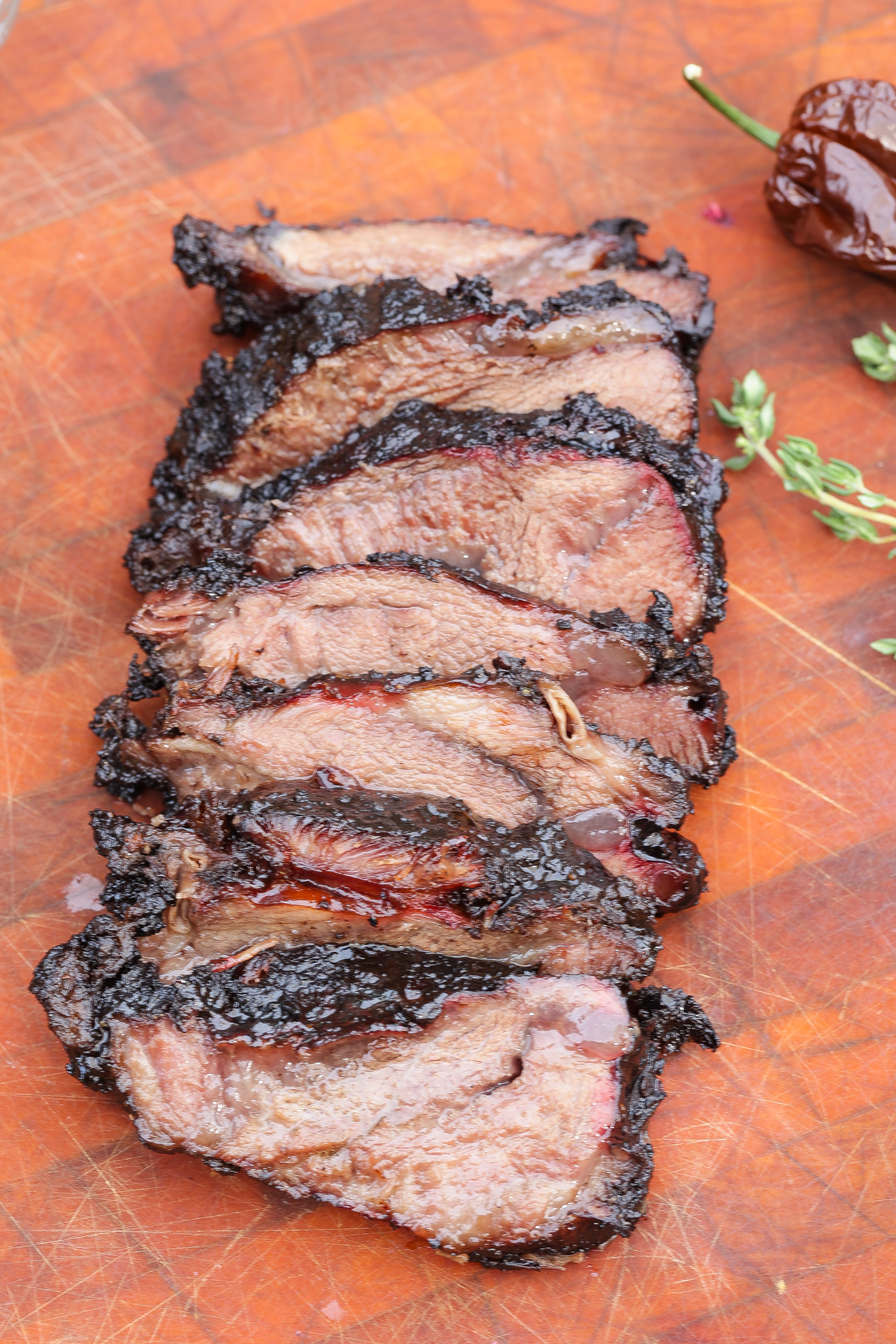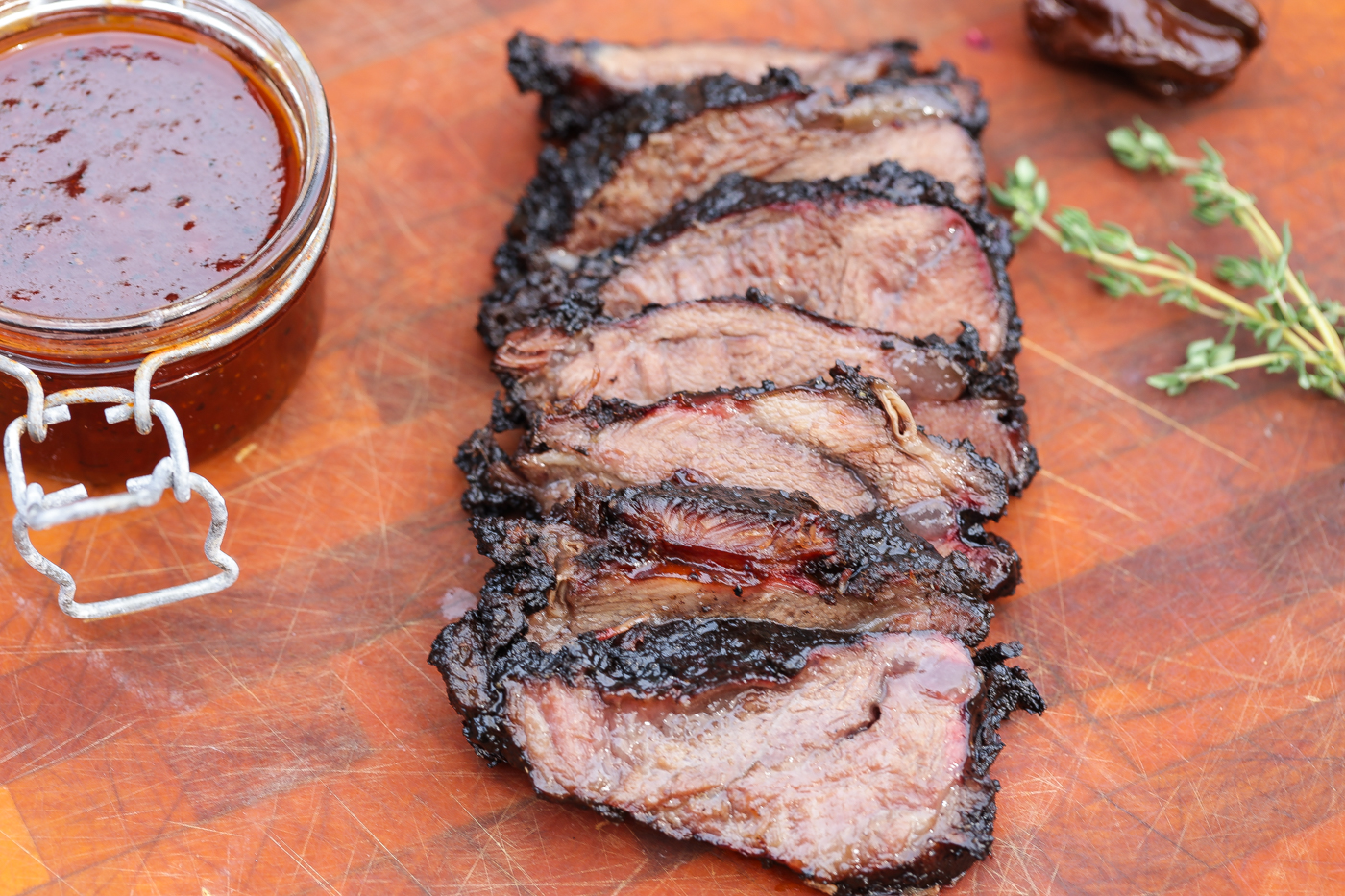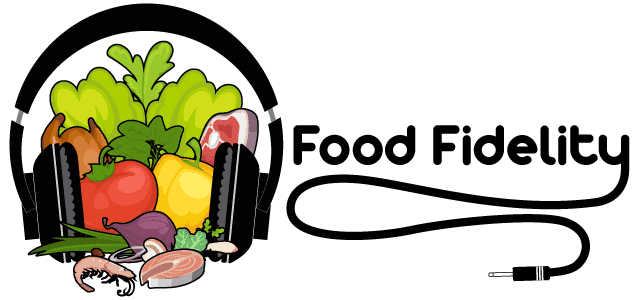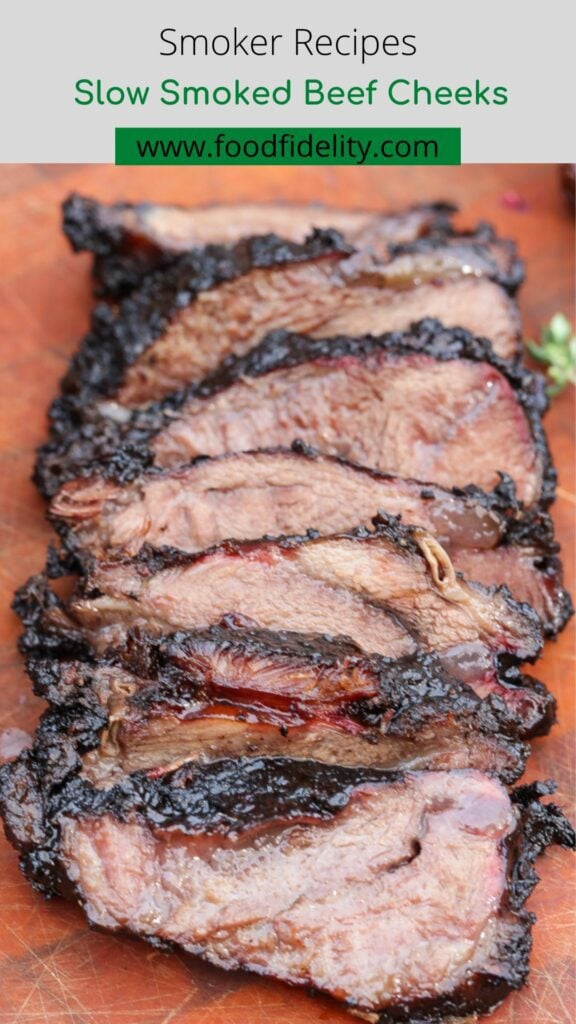Imagine the rich, deep flavors of smoked beef cheeks infused with the bold, spicy essence of jerk seasoning. This dish is a harmonious blend of culinary traditions, where the slow smoking process tenderizes the beef cheeks to perfection, and the jerk seasoning adds a vibrant kick that tantalizes the taste buds.
This dish perfectly marries the slow, tender cooking process with the bold, spicy notes of Caribbean cuisine, creating smoked beef cheeks that offer a taste experience that is both hearty and exhilarating. The result is a culinary experience that resonates with depth and emotion, much like the heartfelt melodies of a deep old school soul music song.
Related Smoked Beef Posts:
- Texas Smoked Brisket
- Smoked Beef Ribs
- Nigerian Beef Suya Skewers

What Are Beef Cheeks
Cheeks are a beef cut from the facial muscles of a cow. They are known for their rich flavor and tenderness when cooked properly. If you're familiar with oxtail (which are actually beef, but note we don't call beef cheeks ox cheeks) when slow cooked they have that same super rich beefy flavor and tenderness. Here are some key points about beef cheeks:
Characteristics
- Flavor:
- Beef cheeks have a deep, beefy flavor due to the high amount of connective tissue and marbling.
- Texture:
- They are tough when raw because the cheek muscles are heavily worked. However, with slow cooking methods, the connective tissue breaks down, resulting in incredibly tender and succulent meat.
- Appearance:
- Raw beef cheeks are relatively small, irregularly shaped cuts with a good amount of fat and connective tissue.
Beats and Eats (music to pair with beef cheeks)
Eunice Collins' song "At The Motel" is a great pairing with this dish. It is a soulful, smooth track that creates a relaxed and intimate atmosphere. Smoked beef cheeks, being a rich and savory dish, also contribute to a sense of indulgence and relaxation. The slow tempo and sensual melody of the song complement the slow-cooking process of smoking beef cheeks, which is all about patience and savoring the moment.
The deep, smoky flavors of beef cheeks align with the rich, velvety tones of Eunice Collins' voice, creating a harmonious sensory experience. Both the song and the dish provide comfort and pleasure.
Just as a great wine pairs well with a fine meal, music can complement food. "At the Hotel" provides a soft, melodic background that enhances the dining experience without overpowering the flavors of the smoked beef cheeks. Listening to a soulful track like "At the Hotel" can make the experience of eating smoked beef cheeks more immersive and enjoyable, allowing you to savor each bite and each note.
Ingredients Needed To Make Jerk Smoked Beef Cheeks
- Beef Cheeks
- Jamaican Jerk Paste (make your own or use store-bought). You can also simply season with your favorite beef BBQ rub
How To Smoke Beef Cheeks (step by step)
If using jerk paste apply liberally to the beef cheeks. Refrigerate and marinate overnight. If using alternative seasoning follow the same approach.
Prepare smoker for indirect cooking preheating the grill to cook between 225-250 degrees F.
Remove cheeks from refrigerator. Place cheeks on the grill grates and smoke at 250 for about 2 hours.
Remove from smoker and wrap tightly in butcher paper before adding back to the smoker and cooking another hour. You basically want to smoke until the target internal temperature reaches 200 degrees F. Allow to rest 10 minutes before serving. Cheeks will reach internal temps of about 205 degrees while off heat.

What To Serve with Beef Cheeks
Smoked beef cheeks are rich and flavorful, and they pair wonderfully with a variety of sides that complement their taste and texture. Here are some ideas for what to serve with smoked beef cheeks:
- Grilled Vegetables: A mix of grilled vegetables like asparagus, bell peppers, zucchini, and red onions adds a smoky flavor and crunchy balance to the meal.
- Coleslaw: A tangy and crunchy coleslaw can provide a refreshing contrast to the rich beef cheeks. Consider using a vinegar-based dressing for a lighter option.
- Mac and Cheese: A rich, cheesy mac and cheese can complement the smoky beef cheeks perfectly. Opt for a baked version with a crispy topping for extra texture.
- Cornbread: Sweet, moist cornbread can be a delightful side that pairs well with the savory, smoky flavor of the beef cheeks.
- Roasted Brussels Sprouts: The slight bitterness of roasted Brussels sprouts can balance the richness of the beef cheeks. Add a balsamic glaze for extra flavor.
- Potato Salad: A well-seasoned potato salad, whether it's creamy or vinegar-based, can be a great side dish that complements the smokiness of the beef.
- Baked Beans: Sweet and savory baked beans can add a comforting and hearty element to the meal.
Tips for Cooking Beef Cheeks
Trim the cheeks of excess fat. There will be a lot and if you don't trim it away you could end up netting more fat than beef after smoking.
Season as you see fit. I had some excess jerk marinade on hand so wanted to use it up before it went bad. Dry spice rubs are a great idea, especially any kind that you use for other beef recipes like brisket or oxtail.
Marinating adds deeper flavor so if you have time I definitely recommend adding this step. People get real creative with their marinades. Yellow mustard is somewhat common one as the acidity is a great tenderizer. But with all the fatty connective tissues and slow cooking you will not need much in the tenderizing component.
You don't want to cook beef cheeks directly over your heat source as they need time to cook. Indirect cooking over low heat is the way to go. For maximum tenderness you want to control temps so you stay under 250 degrees.
In my research I've seen recipes calling for a braising step where after smoking, the cheeks are cooked in a beef stock based liquid to maximize tenderness. Though I can see how you can add flavor with the step it is not necessary. That smoke gets it done along with the seasoning of choice.
Beef checks make for great leftovers as they are easy to reheat. I like them as filling for beef cheek tacos, quesadillas, and empanadas.
I serve these cut into smaller chunks. I'm not a fan of shredded beef cheeks unless they are part of another dish like nachos or something.
Recipe Variations
Smoked beef cheeks are versatile and can be prepared in various ways to create different flavor profiles and textures. Here are some variations to consider:
- Classic Smoked Beef Cheeks:
- Ingredients: Beef cheeks, salt, pepper, garlic powder, onion powder, paprika.
- Method: Season the beef cheeks with the spices and smoke them low and slow until tender.
- Mexican-Style Smoked Beef Cheeks (Barbacoa):
- Ingredients: Beef cheeks, chipotle peppers in adobo, cumin, oregano, garlic, lime juice.
- Method: Marinate the beef cheeks with the adobo sauce and spices, then smoke them. Shred and serve in tacos or burritos.
- Coffee-Rubbed Smoked Beef Cheeks:
- Ingredients: Beef cheeks, ground coffee, brown sugar, paprika, chili powder, salt, pepper.
- Method: Create a coffee-based rub and apply it to the beef cheeks before smoking. The coffee adds a deep, rich flavor.
- Sweet and Smoky Beef Cheeks:
- Ingredients: Beef cheeks, brown sugar, honey, smoked paprika, mustard powder.
- Method: Apply a sweet rub to the beef cheeks and smoke them. Finish with a glaze of honey and mustard.
- Smoked Beef Cheeks with Chimichurri:
- Ingredients: Beef cheeks, salt, pepper, garlic, olive oil, parsley, cilantro, red wine vinegar.
- Method: Smoke the beef cheeks with simple seasoning and serve with a fresh chimichurri sauce.
Frequently Asked Questions (FAQs)
What are the best cooking methods for beef cheeks?
The best methods for cooking beef cheeks include braising, slow roasting, sous vide, and smoking. These methods break down the tough connective tissue, resulting in tender meat.
What internal temperature should beef cheeks reach?
Beef cheeks should be cooked to an internal temperature of about 205°F for optimal tenderness.
Can you cook beef cheeks in a slow cooker?
Yes, beef cheeks can be cooked in a slow cooker. Place them in the slow cooker with your choice of liquid (beef stock or broth, wine, or sauce) and cook on low for 6-8 hours or until tender.
Do beef cheeks need to be marinated?
While not necessary, marinating beef cheeks can enhance their flavor. A marinade with acidic components like wine, vinegar, or citrus juice can help tenderize the meat.
What flavors pair well with beef cheeks?
Beef cheeks pair well with rich, bold flavors such as red wine, garlic, rosemary, thyme, and spicy seasonings like jerk or barbecue rubs.
How do you reheat beef cheeks without drying them out?
Reheat beef cheeks slowly in a covered dish in the oven at a low temperature (around 300°F or 150°C) or in a saucepan with a bit of added liquid to keep them moist.
What dishes can you make with beef cheeks?
Beef cheeks can be used in various dishes, including tacos, burritos, stews, soups, and gourmet main courses. They are versatile and can be paired with different sauces and sides.
Make This Beef Cheeks Recipe
Whether for a special gathering or a cozy night in, this dish promises to elevate any occasion with its unique blend of taste and atmosphere.
If you make this beef cheeks recipe or any other recipe please come back and leave me a comment below with your feedback. Definitely take a photo of the dish and be sure to tag #foodfidelity so that I can see them.
You can also keep up with my food exploits as well as original recipes! You can find me on Instagram, Facebook, Twitter, and Pinterest. If you like any of the music you find on the site, visit me at Spotify to find curated monthly playlists.
Lastly, go to my YouTube channel and subscribe to be notified when new weekly videos are uploaded.
Ingredients
- 4 lbs Beef Cheeks
- Jerk Paste
Instructions
- If using jerk paste apply liberally to the beef cheeks. Refrigerate and marinate overnight. If using alternative seasoning follow the same approach.
- Prepare smoker for indirect cooking preheating the grill to cook between 225-250 degrees F.
- Remove cheeks from refrigerator. Place cheeks on the grill grates and smoke at 250 for about 2 hours.
- Remove from smoker and wrap tightly in butcher paper before adding back to the smoker and cooking another hour. You basically want to smoke until the target internal temperature reaches 200 degrees F. Allow to rest 10 minutes before serving. Cheeks will reach internal temps of about 205 degrees while off heat.
Video


